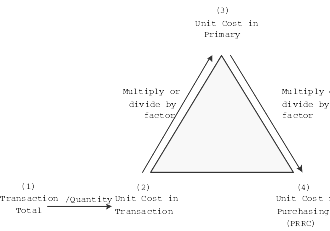Procurement Affected by the Conversion
The base currency conversion programs in JD Edwards EnterpriseOne Procurement, unlike those in JD Edwards EnterpriseOne Sales Order Management, convert both the unit cost and extended cost, as well as the transaction amounts.
Unit costs, extended costs, and transaction amounts are converted:
For a domestic currency order, the original domestic amount is used to derive the new domestic amount.
The original domestic amount becomes the foreign amount.
For a foreign currency order that is in the new base currency (this becomes a domestic order), the foreign amount becomes the new domestic amount.
The original foreign amount is removed.
Note: Because tax fields are domestic currency only, the original domestic tax amount is converted.
After all unit costs, extended costs, and transaction amounts are converted to the new base currency, the conversion programs recalculate the Unit Cost in Purchasing (PRRC).
This graphic is an illustration of Unit Cost in Purchasing recalculations:

To recalculate PRRC in the new base currency, the conversion programs perform calculations in sequential order:
Add the extended price (AEXP) and amount on hold (ACHG) to derive the transaction total (total order amount).
(AEXP) + (ACHG) = (Transaction Total)
Divide the transaction total by the quantity to derive the transaction unit price.
(Transaction Total) / (Quantity) = (Unit Cost in Transaction)
Depending on the unit of measure (UOM) conversion factor from transaction to primary, multiply or divide the factor to derive the Unit Cost in Primary.
(Unit Cost in Transaction) (Ã or /) Factor = (Unit Cost in Primary)
Depending on the UOM conversion factor from primary to purchasing, multiply or divide the factor to derive the Unit Cost in Purchasing (PRRC).
(Unit Cost in Primary) (Ã or /) (Factor) = [Unit Cost in Purchasing (PRRC)]